The AMD 2nd Gen Ryzen Deep Dive: The 2700X, 2700, 2600X, and 2600 Tested
by Ian Cutress on April 19, 2018 9:00 AM ESTPrecision Boost 2 and XFR2: Ensuring It Hertz More
One of the biggest changes for the new Ryzen-2000 series is in how the processor implements its turbo. Up until this point (except the recent APU launch), processors have relied on a step function implementation: the system determines how many threads are loaded, attempts to implement a specific frequency on those cores if possible, and then follows the look-up table relating thread count to frequency. AMD’s goal in Precision Boost 2 is to make this process more dynamic.
This image from AMD is how the feature is being represented: the system will determine how much of the power budget is still available, and turbo as much as possible until it hits one of the limiting factors. These factors can be any of, but not limited to, the following:
- Total chip peak power
- Individual core voltage/frequency response
- Thermal interactions between neighboring cores
- Power delivery limitations to individual cores/groups of cores
- Overall thermal performance
AMD’s new Ryzen Master 1.3 software, when used on a Ryzen 2000-series processor, has several indicators to determine what the limiting factors are. For the most part, the way the processor will boost and respond to the environment, will be transparent to the user.
The best way to test this in action, from my perspective, is to look at the power draw of the first generation and second generation Ryzen processors. We can examine the internal estimated power consumption of each core individually as thankfully AMD has left these registers exposed, to give the following data:
This is only the core consumption power, not the package power, which would include the DRAM controller, the Infinity Fabric, and the processor IO. This means we get numbers different to the rated TDP, but the danger here is that because the Ryzen 7 2700X has a 10W TDP higher than the Ryzen 7 1800X, where the 2700X draws more power it could seem as if that is the TDP response.
Just plotting the power consumption gives this graph:
Even in this case it is clear that the Ryzen 7 2700X is drawing more power, up to 20W more, for a variable threaded load. If we change the graph to be a function of peak power:
The results are not quite as clear: it would seem that the 1800X draws, as a percentage of peak power, more at low thread count, but the 2700X draws more at a middling thread count.
It is worth noting that the end result of Precision Boost 2 is two-fold: more performance, but also more power consumption. Users looking to place one of the lower powered processors into a small form factor system might look at disabling this feature and returning to a standard step-function response in order to keep the thermal capabilities in check.
A side note – despite the marketing name being called ‘Precision Boost 2’, the internal BIOS name is called ‘Core Performance Boost’. It sounds similar to Multi-Core Enhancement, which is a feature on some Intel motherboards designed to go above and beyond the turbo mechanism. However, this is just AMD’s standard PB2: disabling it will disable PB2. Initially we turned it off, thinking it was a motherboard manufacturer tool, only to throw away some testing because there is this odd disconnect between AMD’s engineers and AMD’s marketing.
Extended Frequency Range 2 (XFR2)
For the Ryzen 2000-series, AMD has changed what XFR does. In the previous generation it was applied on certain processors to allow them to boost above the maximum turbo frequency when the thermal situation was conducive to higher frequencies and higher voltage in low thread-count states. For this generation, it still relates to thermals, however the definition is applied to any core loading: if the CPU is under 60ºC, the processor can boost no matter what the loading is above its Precision Boost 2 frequency (so why not get a better PB2 implementation?). The core still has to be within a suitable voltage/frequency window to retain stability, however.
On certain motherboards, like the ASUS Crosshair VII Hero, there are additional options to assist XFR2 beyond AMD’s implementation. ASUS does not go into specific details, however I suspect it implements a more aggressive version, perhaps extending the voltage/frequency curve, raising the power limits, and/or adjusting the thermal limit.


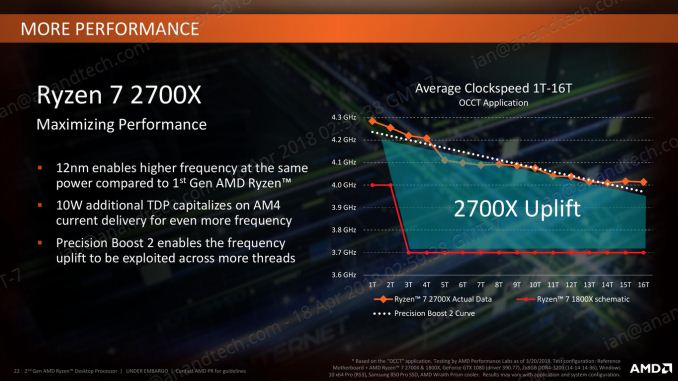
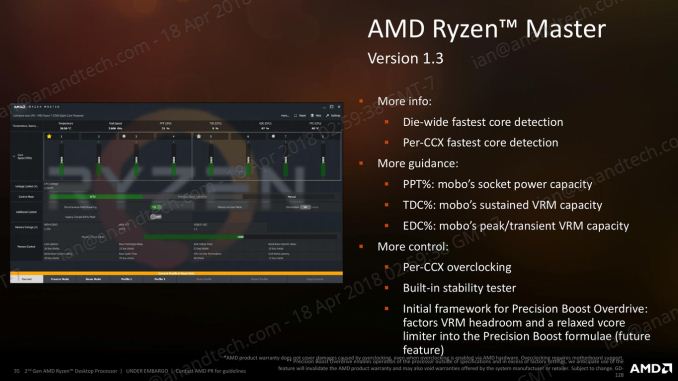

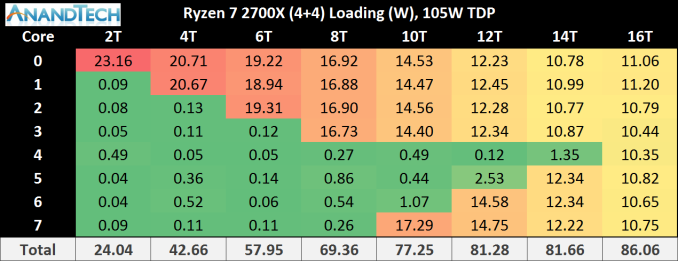
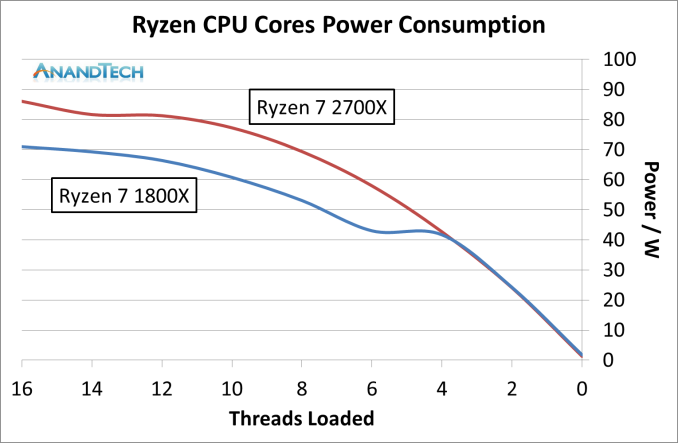
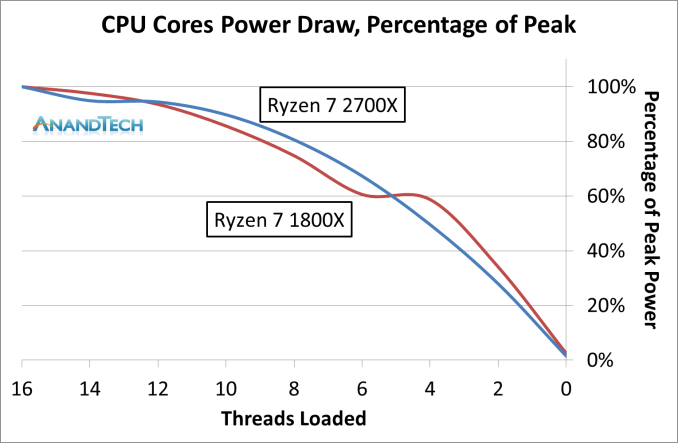
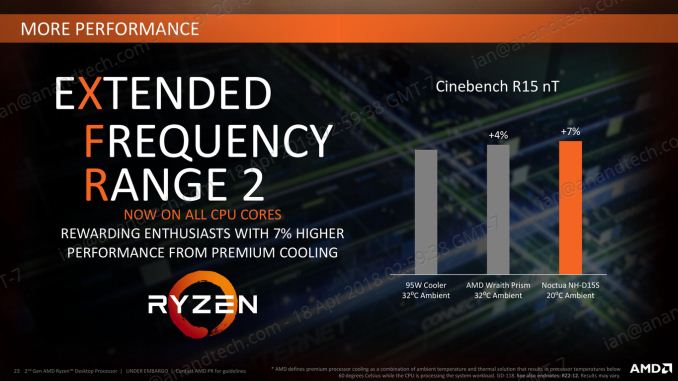








545 Comments
View All Comments
fallaha56 - Thursday, April 19, 2018 - link
I’m not -I’m jst showing how stupid your OP wasIf someone is selling an entry level chip for the same price as someone else’s that’s the comparison
Include the platform costs if you like but that’s what matters -bang for buck
Only for .1% of people does performance at any costs matter
Ninjawithagun - Thursday, April 19, 2018 - link
Actually no. Once again proving you do not know how to count to 8.LurkingSince97 - Thursday, April 19, 2018 - link
Um... NO.Sure, in some cases it is possible to compare two processors of 'equal quality' and then look at cost second.
But that is an impossible task in a review. And for some processors it is impossible for anyone.
This is impossible because there is no such thing as an 'equal quality chip'. Subjectively, I might be able to find two chips that I think are roughly equal, then compare price. But this is subjective -- depending on what my needs are.
Price is objective. We can compare two system builds at nearly equal cost directly, then see what is better. Comparing 'roughly equal' chips first starts out in the wrong place for most consumers. Only those that are not very price sensitive do that -- get the 'best' for what they want, and if there are two equal things use price as a tie breaker. Most people are looking for the best they can get for a price, rather than the lower price for what they want.
Now, to make it worse, by your reasoning the 2700X can not be compared to anything, because the core counts differ. Bull$#17. I could just as easily say that the 8700K can not be compared to the 2600X because it can overclock to 5Ghz, so they are not technically the same.
There is absolutely reason to compare 8C/16T products to 6C/12T to 4C/8T products -- BECAUSE PEOPLE HAVE TO PICK ONE TO BUY.
LurkingSince97 - Thursday, April 19, 2018 - link
Incorrect. Q.E.D.bji - Thursday, April 19, 2018 - link
You are completely wrong, and Krysto is correct. Performance per dollar is the metric of greatest relevance for the vast majority of users and thus is the most useful metric to use in reviews.mapesdhs - Saturday, April 21, 2018 - link
Maybe Ninjawithagun is just crazy rich and doesn't care about price. :)Targon - Monday, April 23, 2018 - link
Performance per dollar for the workload you care about is what you are talking about, since game performance doesn't matter much in business, but being able to do whatever the day to day work as quickly as possible is. That may mean lower core counts with high clock speeds will be more important, or higher core counts will beat out most other things(16+ cores at 1.5GHz might beat out 4 cores at 5GHz). It all depends.Ryan Smith - Thursday, April 19, 2018 - link
"Why does every review keep making the same mistake?? It has nothing to do with price. Comparing like CPU architectures is the only logical course of action."To abuse an already overused meme here, why not both? This is why we have the data for all of these parts.
Our focus is on price comparisons, because at the end of the day most readers will make their buying decisions around a given budget. But there is also plenty here looking into IPC and other architectural elements.
Cooe - Thursday, April 19, 2018 - link
Lol don't feed him Ryan! As one of our so gracious and glorious overloads it pains me to see you get into the mud with that dingus. Leave that to us nobodies :).Ninjawithagun - Thursday, April 19, 2018 - link
Ignorance is your bliss.